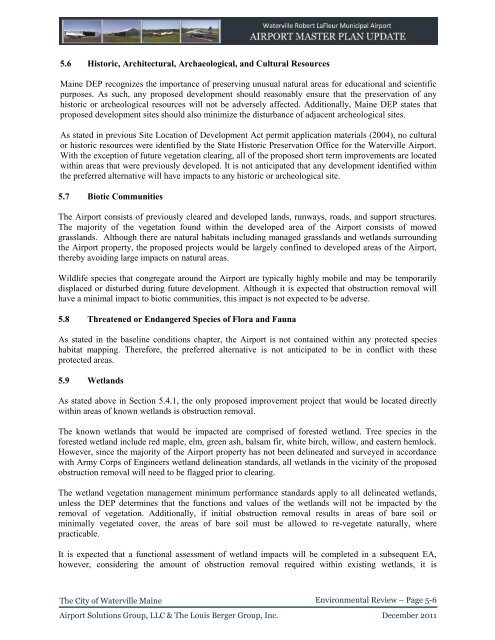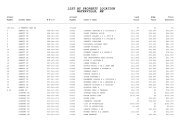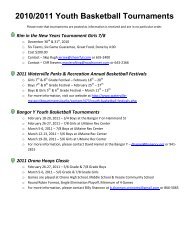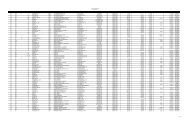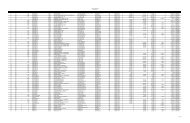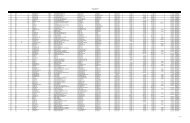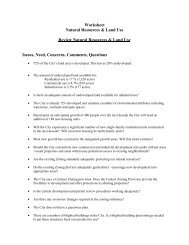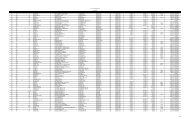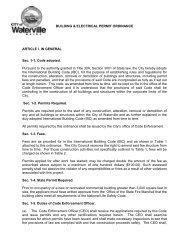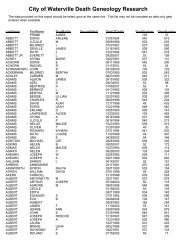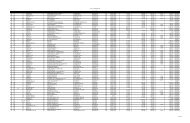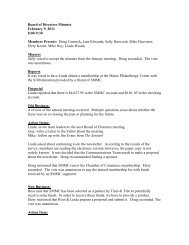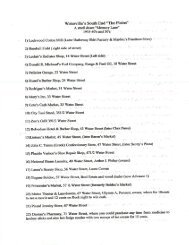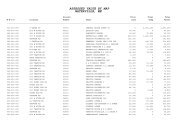Airport Master Plan 2012 - City of Waterville
Airport Master Plan 2012 - City of Waterville
Airport Master Plan 2012 - City of Waterville
You also want an ePaper? Increase the reach of your titles
YUMPU automatically turns print PDFs into web optimized ePapers that Google loves.
5.6 Historic, Architectural, Archaeological, and Cultural Resources<br />
Maine DEP recognizes the importance <strong>of</strong> preserving unusual natural areas for educational and scientific<br />
purposes. As such, any proposed development should reasonably ensure that the preservation <strong>of</strong> any<br />
historic or archeological resources will not be adversely affected. Additionally, Maine DEP states that<br />
proposed development sites should also minimize the disturbance <strong>of</strong> adjacent archeological sites.<br />
As stated in previous Site Location <strong>of</strong> Development Act permit application materials (2004), no cultural<br />
or historic resources were identified by the State Historic Preservation Office for the <strong>Waterville</strong> <strong>Airport</strong>.<br />
With the exception <strong>of</strong> future vegetation clearing, all <strong>of</strong> the proposed short term improvements are located<br />
within areas that were previously developed. It is not anticipated that any development identified within<br />
the preferred alternative will have impacts to any historic or archeological site.<br />
5.7 Biotic Communities<br />
The <strong>Airport</strong> consists <strong>of</strong> previously cleared and developed lands, runways, roads, and support structures.<br />
The majority <strong>of</strong> the vegetation found within the developed area <strong>of</strong> the <strong>Airport</strong> consists <strong>of</strong> mowed<br />
grasslands. Although there are natural habitats including managed grasslands and wetlands surrounding<br />
the <strong>Airport</strong> property, the proposed projects would be largely confined to developed areas <strong>of</strong> the <strong>Airport</strong>,<br />
thereby avoiding large impacts on natural areas.<br />
Wildlife species that congregate around the <strong>Airport</strong> are typically highly mobile and may be temporarily<br />
displaced or disturbed during future development. Although it is expected that obstruction removal will<br />
have a minimal impact to biotic communities, this impact is not expected to be adverse.<br />
5.8 Threatened or Endangered Species <strong>of</strong> Flora and Fauna<br />
As stated in the baseline conditions chapter, the <strong>Airport</strong> is not contained within any protected species<br />
habitat mapping. Therefore, the preferred alternative is not anticipated to be in conflict with these<br />
protected areas.<br />
5.9 Wetlands<br />
As stated above in Section 5.4.1, the only proposed improvement project that would be located directly<br />
within areas <strong>of</strong> known wetlands is obstruction removal.<br />
The known wetlands that would be impacted are comprised <strong>of</strong> forested wetland. Tree species in the<br />
forested wetland include red maple, elm, green ash, balsam fir, white birch, willow, and eastern hemlock.<br />
However, since the majority <strong>of</strong> the <strong>Airport</strong> property has not been delineated and surveyed in accordance<br />
with Army Corps <strong>of</strong> Engineers wetland delineation standards, all wetlands in the vicinity <strong>of</strong> the proposed<br />
obstruction removal will need to be flagged prior to clearing.<br />
The wetland vegetation management minimum performance standards apply to all delineated wetlands,<br />
unless the DEP determines that the functions and values <strong>of</strong> the wetlands will not be impacted by the<br />
removal <strong>of</strong> vegetation. Additionally, if initial obstruction removal results in areas <strong>of</strong> bare soil or<br />
minimally vegetated cover, the areas <strong>of</strong> bare soil must be allowed to re-vegetate naturally, where<br />
practicable.<br />
It is expected that a functional assessment <strong>of</strong> wetland impacts will be completed in a subsequent EA,<br />
however, considering the amount <strong>of</strong> obstruction removal required within existing wetlands, it is<br />
The <strong>City</strong> <strong>of</strong> <strong>Waterville</strong> Maine<br />
Environmental Review – Page 5-6<br />
<strong>Airport</strong> Solutions Group, LLC & The Louis Berger Group, Inc. December 2011


